This homemade spaghetti alla chitarra recipe with tiny meatballs is a unique traditional pasta recipe from Abruzzo, Central Italy. Abruzzo is the only Italian region where you will find this delicious dish, unless you make it yourself! Definitely worth doing!
Spaghetti alla chitarra con pallotine.
On a recent trip to Abruzzo, we enjoyed spaghetti alla chitarra with tiny meatballs (called pallotine) at a small restaurant on the Abruzzo coast. It was so good, I was inspired to make it myself once we got home!
Although this recipe takes a bit of time to make, the ingredients are easily available everywhere. The only problem may be getting your hands on a chitarra, the traditional tool used to make the pasta!


What is a chitarra?
As the name suggests, chitarra means guitar in Italian. However, in this case, we aren’t talking about a musical instrument. We are referring to a pasta making tool originally from Abruzzo. Nowadays, this tool is made of a beech wood frame that has steel strings strung across it lengthwise, like a guitar.
In fact, when releasing the ready spaghetti from the chitarra, you need to strum the steel strings if the pasta sticks a bit! Actually, rather musical!
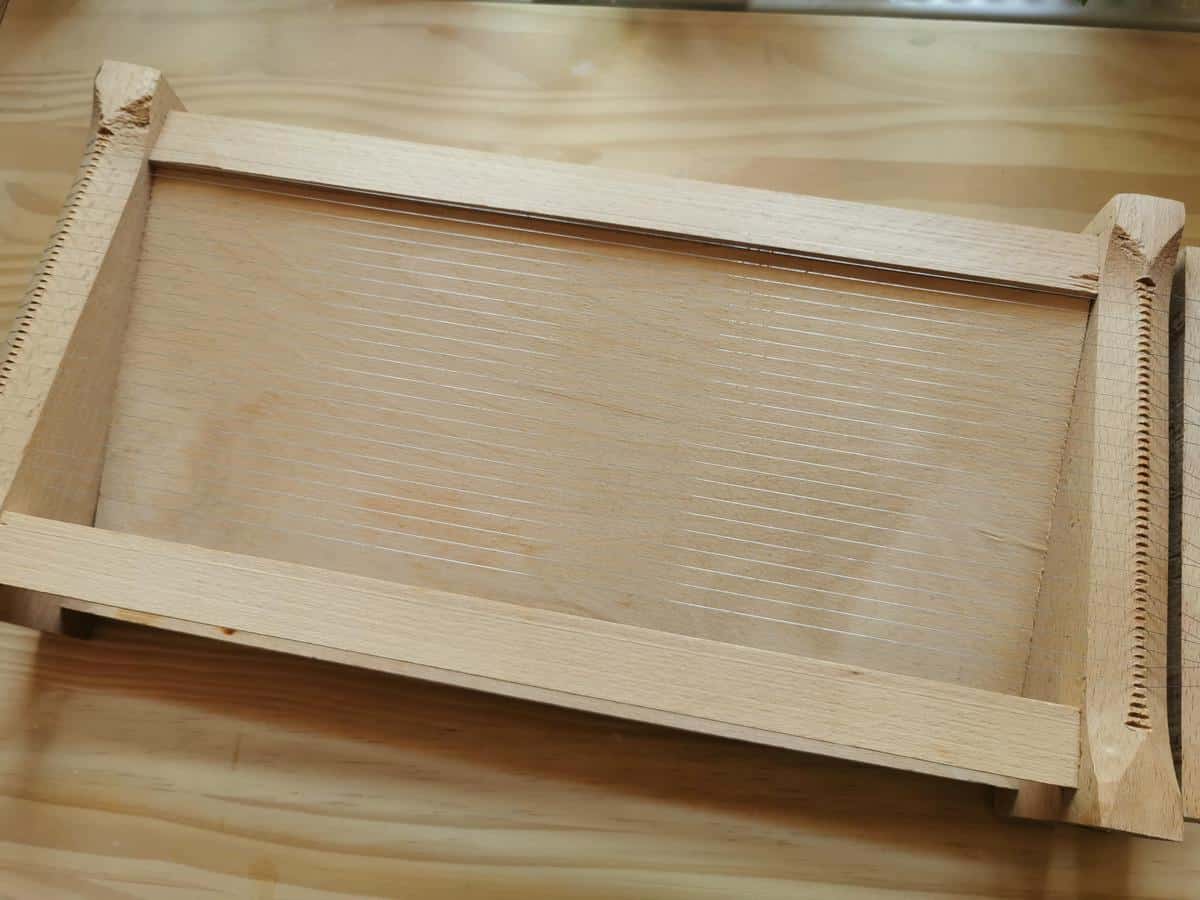

I have read that the steel strings on a chitarra are actually one string which is manually inserted on the wooden frame and then tightened with screws or wooden stoppers. In fact, if one line breaks, you have to replace the whole string on both sides.
I’m not sure if this is true of all modern guitar pasta makers. Nowadays, you can buy a chitarra with strings on both sides. The narrowly spaced strings are for spaghetti alla chitarra, and the wider strings can be used to make tagliatelle.
History
According to one article I found, the first written evidence of a chitarra dates to 1871 when the tool for making pasta was mentioned in a notary’s document, as part of a bride’s dowry! However, it’s likely that this pasta tool was in use long before that.
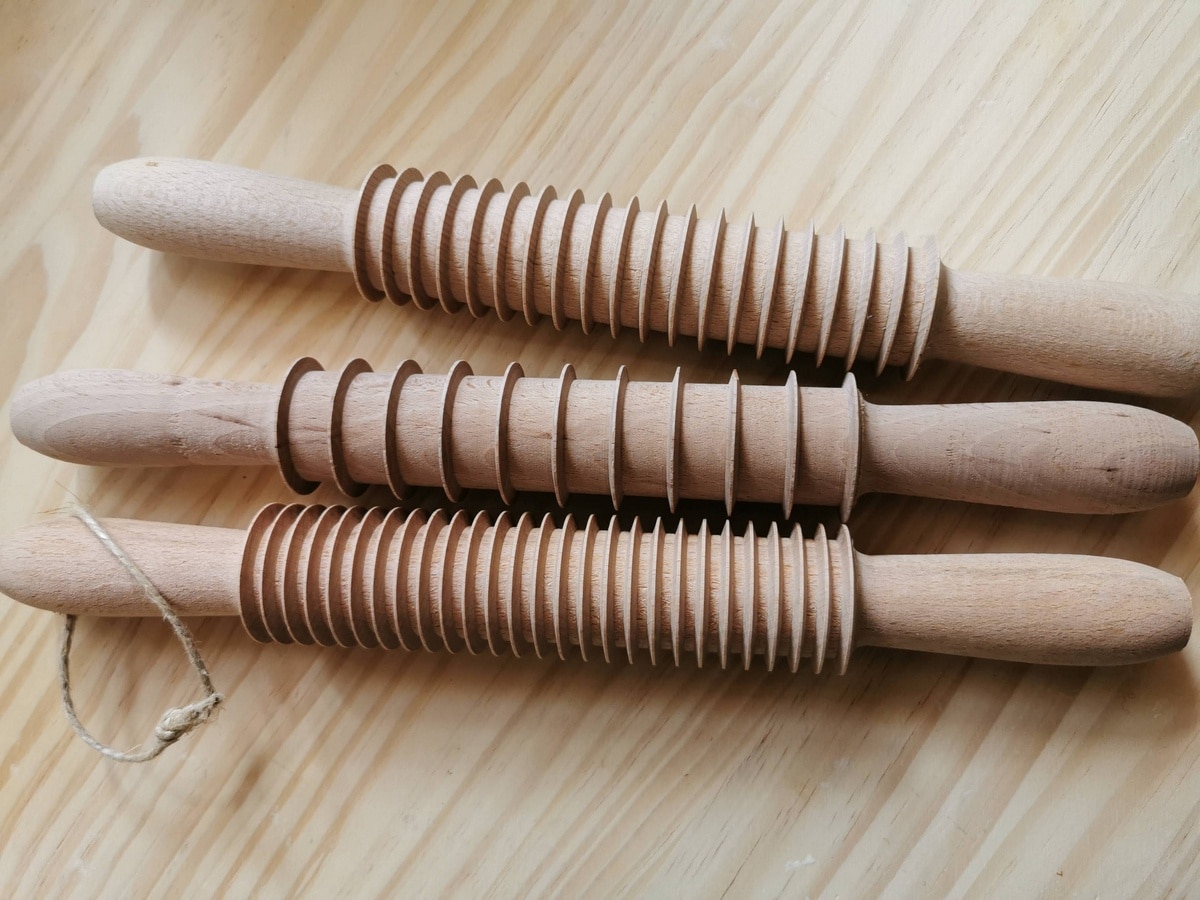

The ancestor of the chitarra was a wooden cutter rolling pin known as ‘lu rentrocelo’, in the local dialect. You can find both tools for sale here in Italy and online.
When buying a chitarra, it’s important to be sure that the strings are stainless steel. In the past they were made from copper or brass, which rusted. Cheaper versions sometimes have plastic strings which don’t work well.
What is the difference between normal spaghetti and spaghetti alla chitarra?
Unlike traditional spaghetti, which is actually round, spaghetti alla chitarra is square cut and has a rougher surface. These unique characteristics allow the sauce to adhere better to the pasta.
Nowadays, you can buy dried spaghetti alla chitarra or other square cut spaghetti often called quadratti. These can substitute the spaghetti in this alla termana recipe if you can’t make the pasta yourself.


Spaghetti alla chitarra with tiny meatballs.
Also known as chitarrine or chitarra alla teramana, this particular spaghetti alla chitarra recipe comes from the province and city of Teramo in Abruzzo, hence the name. Some people refer to this recipe as the original spaghetti with meatballs and its origins are certainly older than the dish enjoyed in the USA. However, here the meatballs are really tiny, adding a meaty flavour to the sauce without becoming the main focus of the dish.


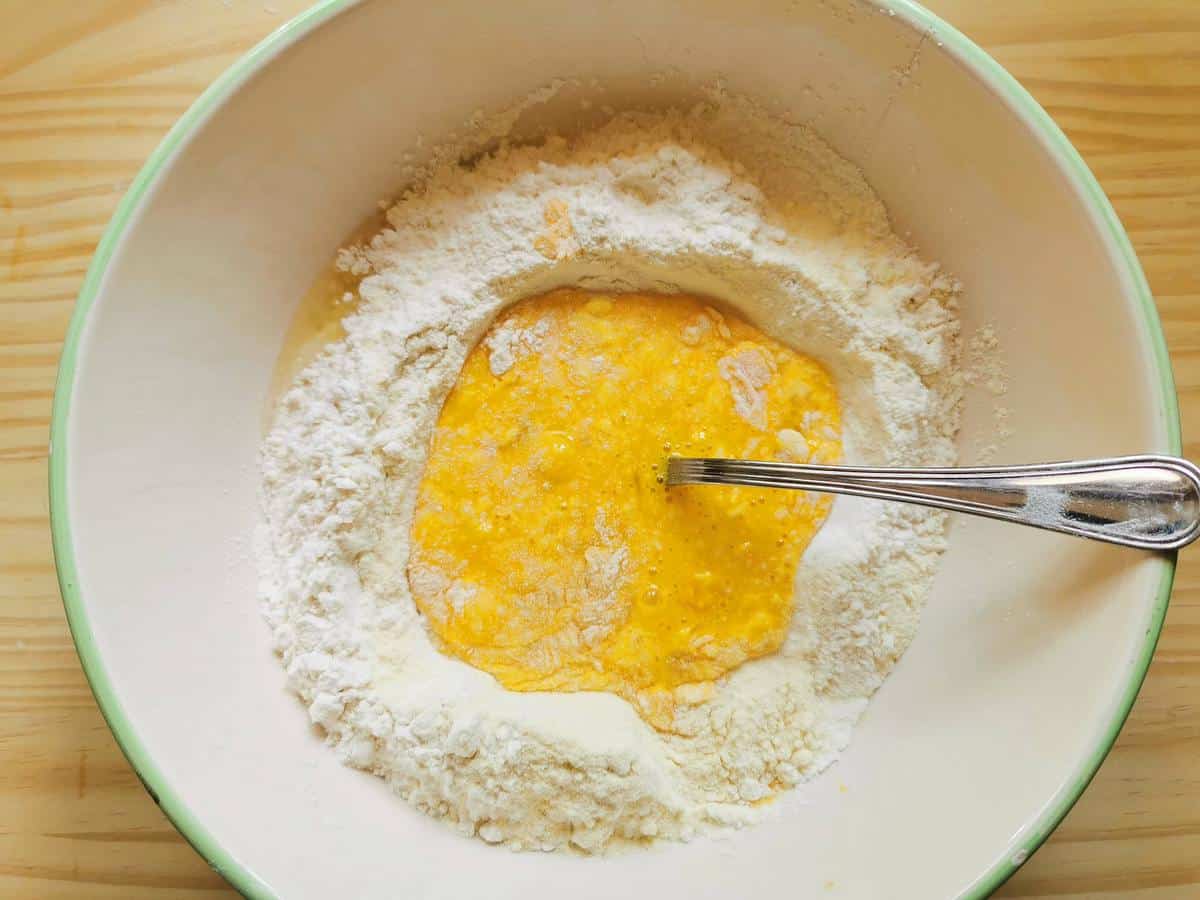

Different versions of chitarra alla Teramana.
Like other traditional and ancient Italian pasta recipes, there are different versions of this recipe. Some people make the meatballs very simply with just ground veal or beef, olive oil, salt and pepper. In the version I followed, the meatballs are richer and combine cheese, egg and nutmeg with the meat. Other recipes include breadcrumbs in the meatballs.
The accompanying sauce for this spaghetti alla chitarra recipe can also differ from one cook to another. In some cases, the sauce contains different cuts of meat such as lamb chops, pork ribs and beef or veal. Other versions, like the one I made, call for a simple meat free tomato sauce.
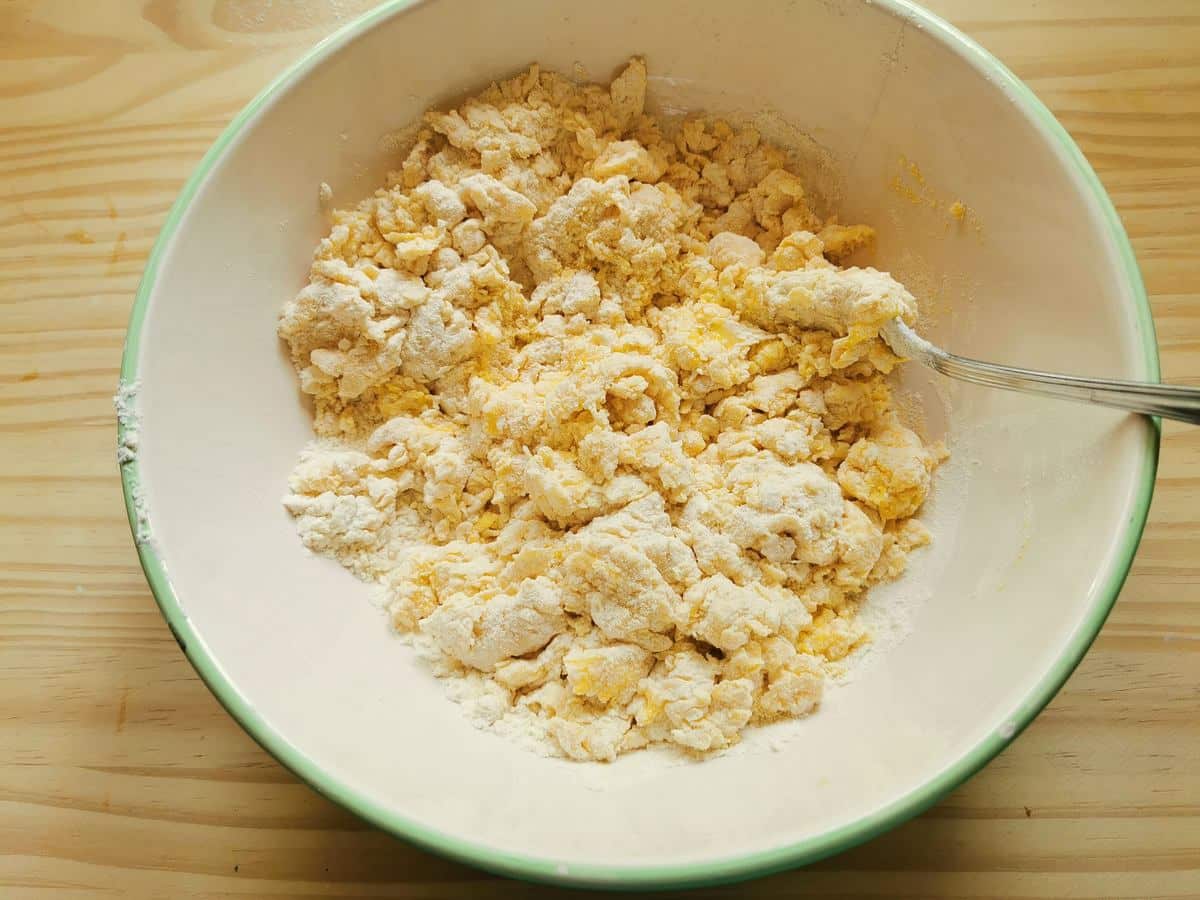



When I search on Italian websites for the original spaghetti alla chitarra with tiny meatballs, I get versions with meat in the sauce and versions with no meat in the sauce. I went with a meatless sauce because it’s easier, lighter and healthier. Plus, the dish we enjoyed in Abruzzo recently was also made with just tomato sauce and tiny meatballs.
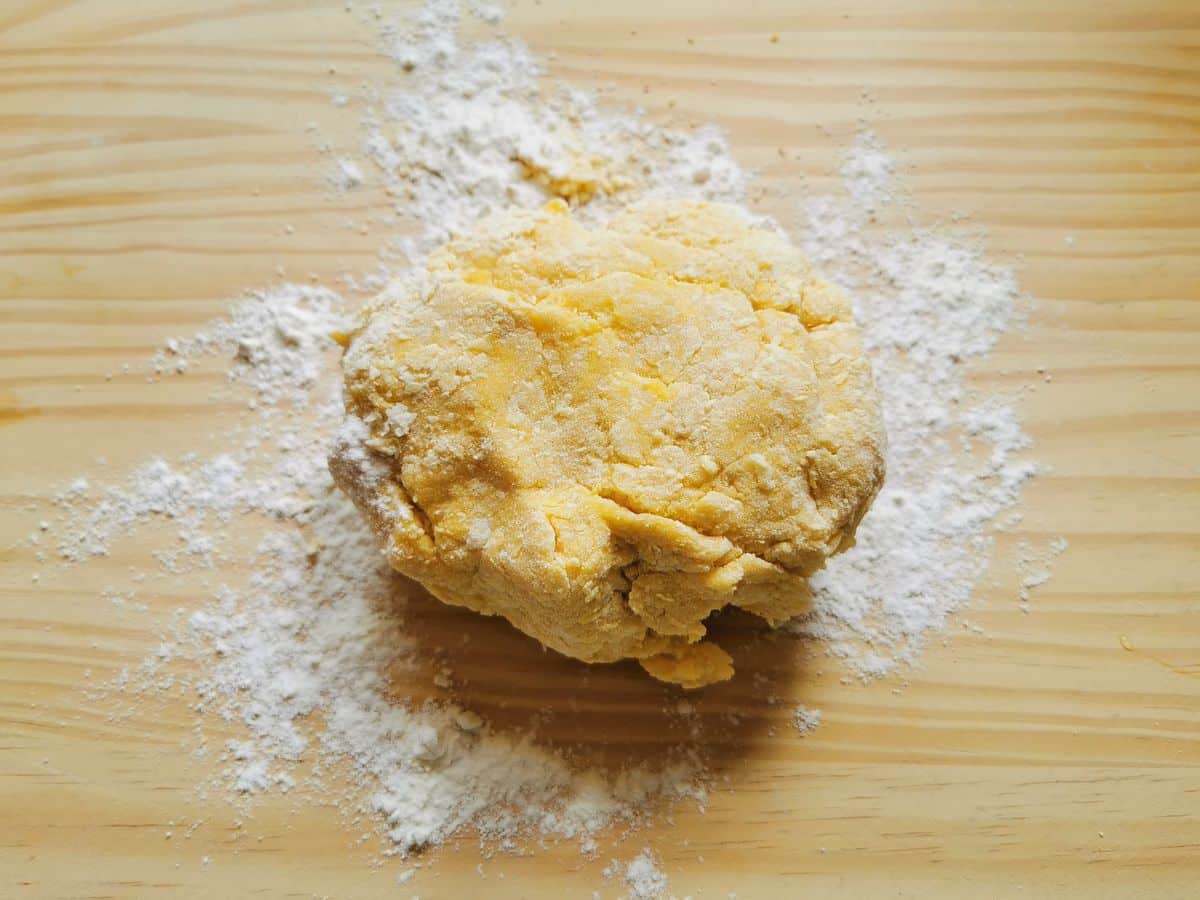



Different ways to make spaghetti alla chitarra.
Similar to there being variety in the ingredients for the sauce, the pasta in this recipe is also made in different ways. You can make spaghetti alla chitarra with just fine soft wheat flour (Italian 00 flour) or coarser soft wheat flour (Italian 0 flour) and eggs, with both soft wheat and hard wheat flour and eggs, and with hard wheat flour only and eggs.
I used both types of flour (200g ‘00’ soft wheat and 100 g hard wheat) plus 3 eggs and a pinch of salt.
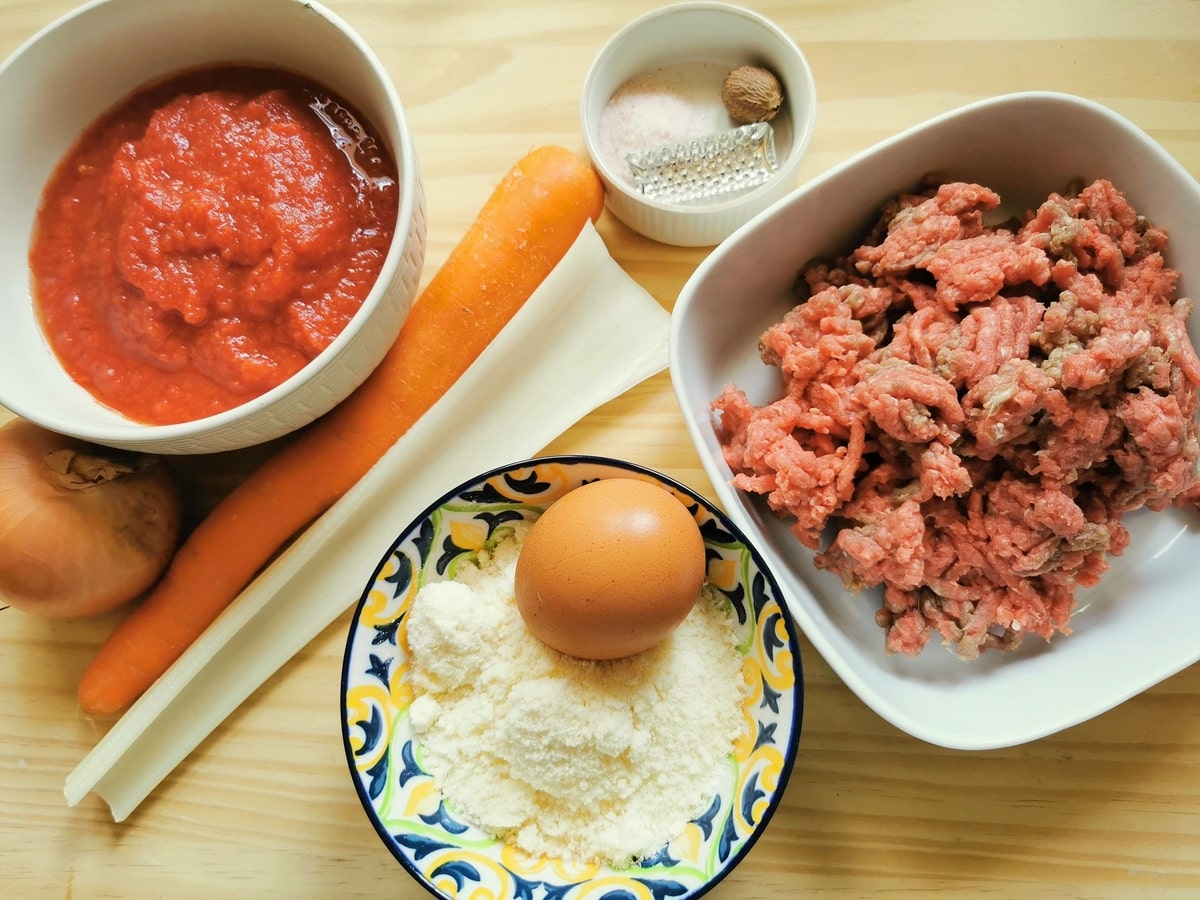

Ingredients you will need for this alla chitarra recipe.
For the pasta dough.
Italian ‘00’ soft wheat flour. Some spaghetti alla chitarra recipes use only soft wheat flour. Here in Italy, that is usually what Italians call ‘00’ flour, which is the finest milled white flour. You can also use Italian ‘0’ flour which is more coarsely ground or all-purpose flour.
Italian durum wheat semolina flour. The recipe I followed called for some hard wheat semolina flour at a ratio of 1:2. (100g semolina flour to 200 g soft wheat flour). Semolina flour is higher in gluten and helps the pasta keep its shape when cooked.
Eggs. I like to use large free range organic eggs brought to room temperature before using.
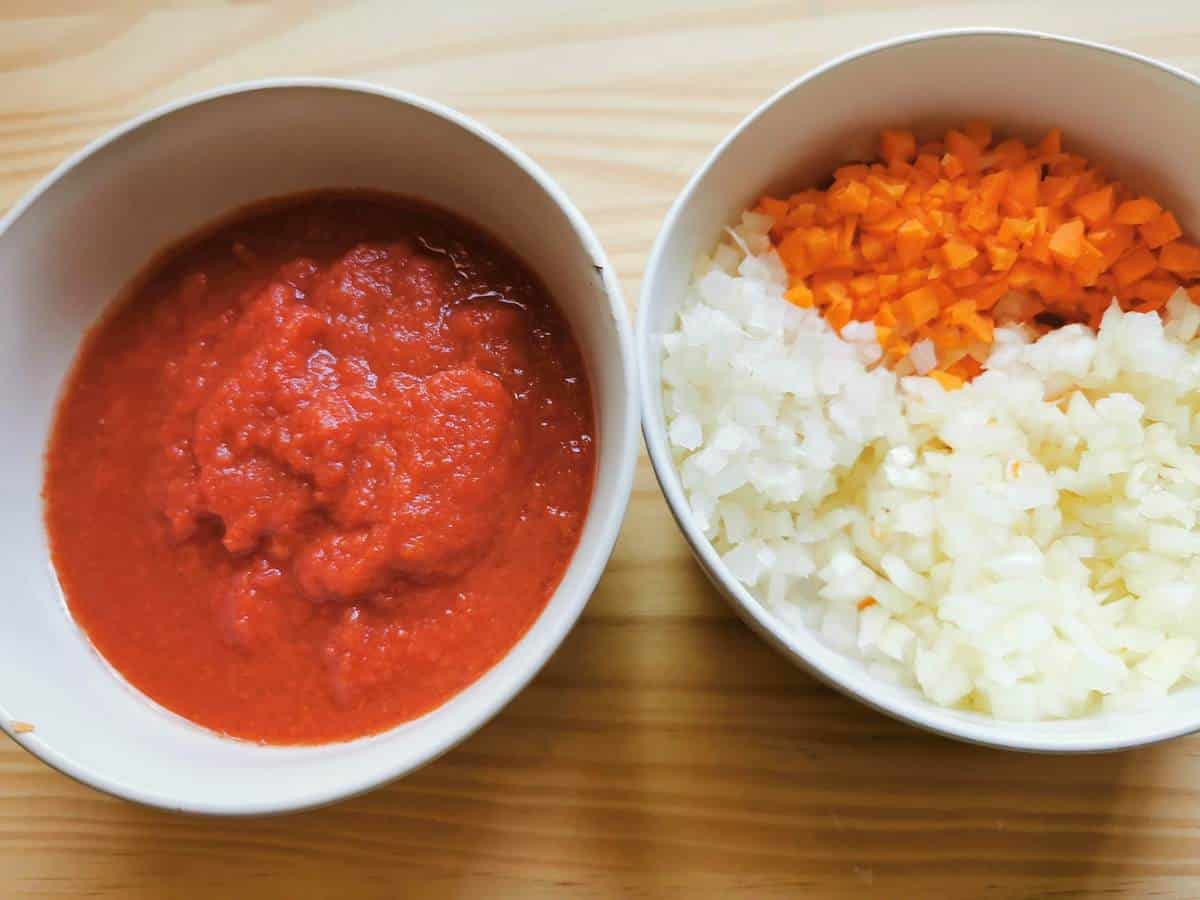



For the tomato sauce.
Carrots, onions and celery: These 3 vegetables make up what Italians call the ‘soffritto’. This is the base of many sauces and soups. It’s the Italian equivalent of the French mirepoix or the Spanish sofrito.
Tomato passata. Italian passata is literally just puréed uncooked tomatoes with no added flavouring. You can also use canned peeled or chopped tomatoes instead. But the sauce may have a thicker consistency.




Seasoning. Salt and pepper. I prefer freshly ground black pepper.
Olive oil. A good quality olive oil will add a better flavour to the sauce.
For the pallotine (tiny meatballs).
Finely ground beef or veal. The meat needs to be finely ground as the meatballs are very small. Both beef and veal are commonly used.
Grated cheese. Traditionally the cheese in the meatballs is Pecorino from Abruzzo. I used Grana. You can also use Pecorino Romano or Parmigiano. Pecorino tends to add a saltier sharper flavour.




Nutmeg. Just ½ a flat teaspoon is enough or even less if you prefer.
1 large egg, preferably free range and organic.
Oil for frying. I used a vegetable oil to fry the meatballs. Some recipes say to boil the meatballs, but I think frying makes them tastier.
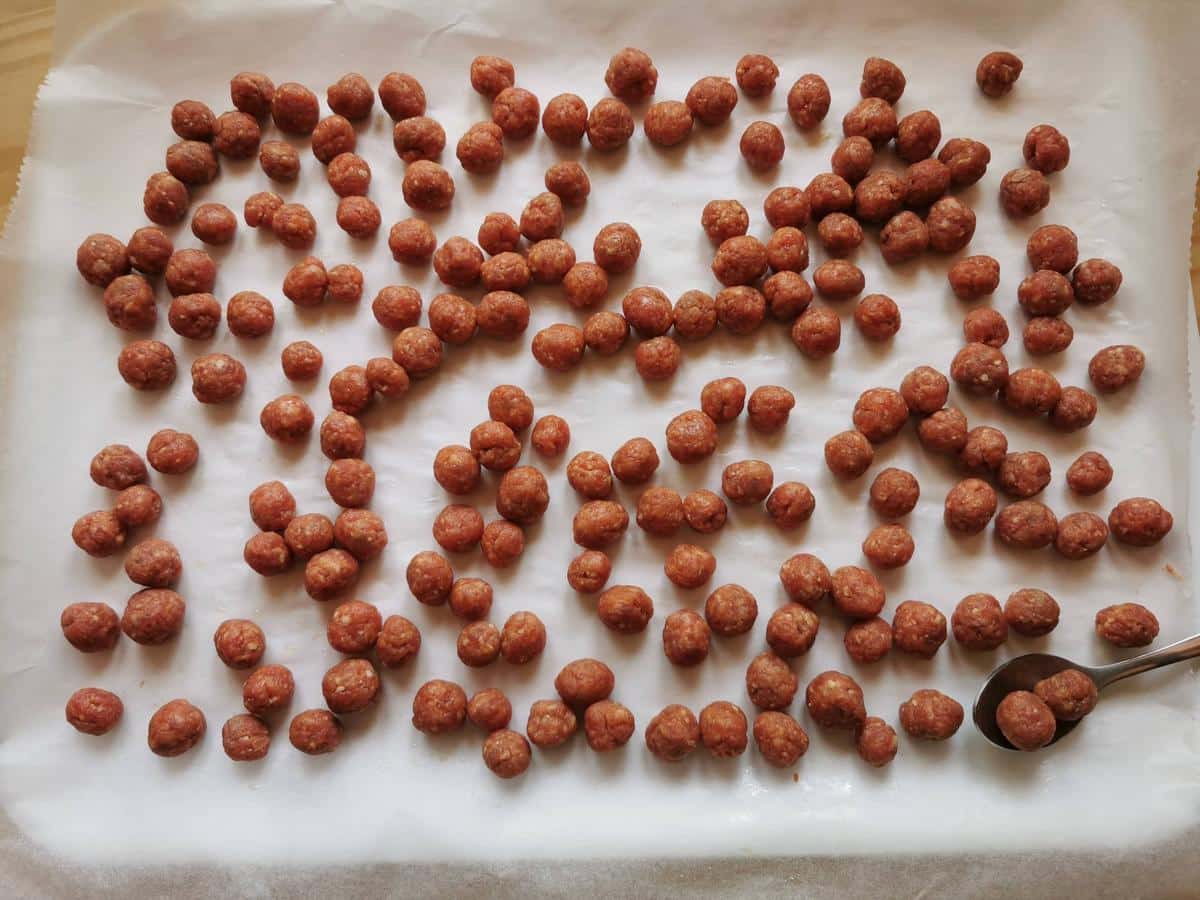



Step by step instructions with tips.
Make the alla chitarra pasta dough.
Sift the ‘00’ flour and semolina flour into a bowl with salt and eggs. Start to beat the eggs with a fork and then mix everything together. It’s better to first use a fork and then with your hands.
Once you have the beginnings of a dough that doesn’t stick to the sides of the bowl, turn the dough out onto a floured work surface, and continue kneading with your hands for 5-10 minutes. Roll the dough into a ball and wrap it in clingfilm (plastic wrap) and let it rest for about 30 minutes.
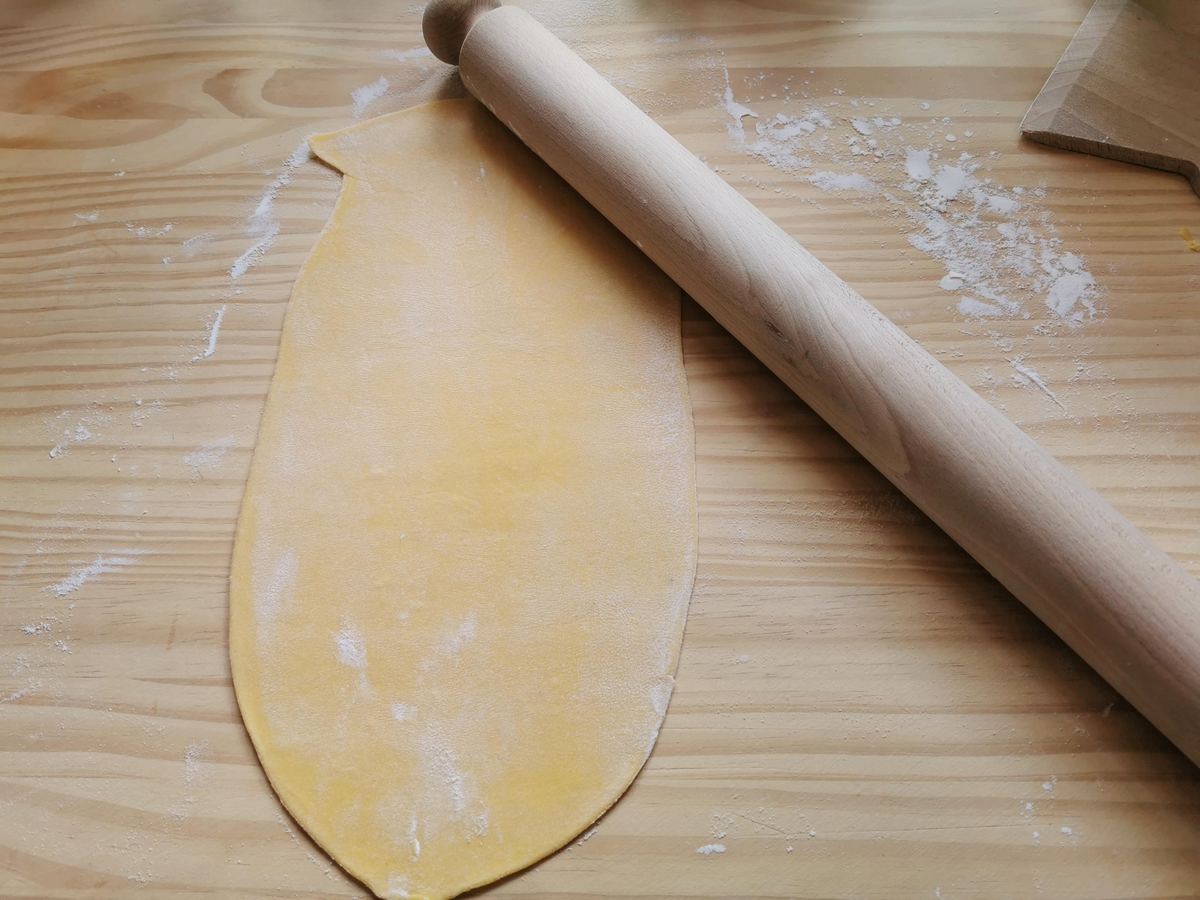

Make the meatballs.
Put the ground meat into a bowl. Add the egg and then the other ingredients. Start mixing everything together with a fork and then use your hands until all the ingredients are well incorporated, but not too compact.
Take very small pieces of the meatball mixture and roll them into tiny balls (1.5-2cm in diameter) using one hand to roll and the palm of your other hand as the rolling surface. Two meatballs should fit on a teaspoon.
Place the meatballs on a flour dusted surface as you make them. You can use oil or water on your hands to make the rolling easier.


Heat some vegetable oil in a frying pan and fry the meatballs until they start to brown on all sides. Don’t let them get too brown. Remove the meatballs and place them in a bowl on some kitchen paper to drain the excess oil. You may need to fry the meatballs in batches.
Make the tomato sauce.
Chop the onion, carrot and celery finely. Heat some olive oil in a deep frying pan, that’s big enough to hold the sauce and pasta together. Sauté the vegetables until they start to soften. Add the tomato passata and simmer for at least 30 minutes. Add salt and pepper to taste.
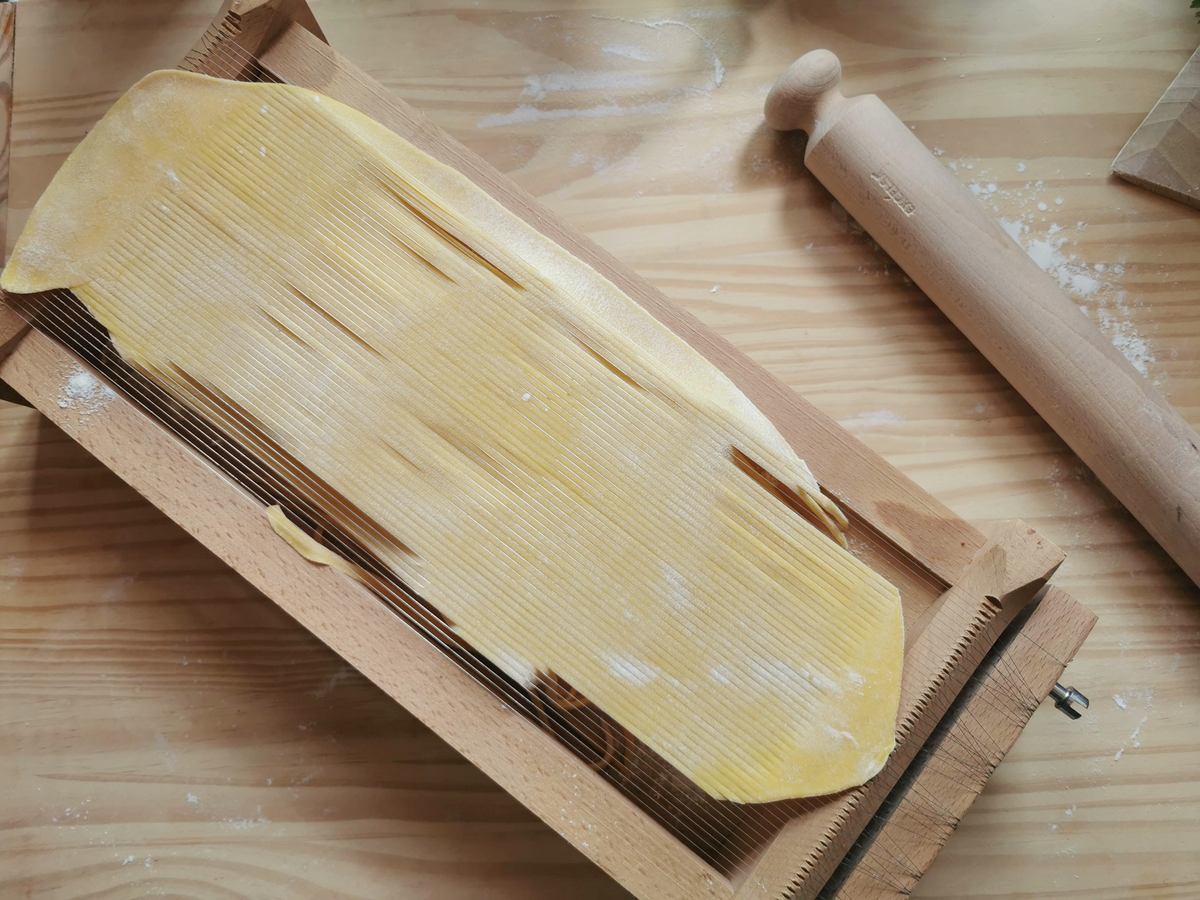

Make the spaghetti alla chitarra.
Cut off about a quarter of the dough and roll it out into a large rectangle on a flour dusted work surface or by using a hand-cranked pasta machine. Aim for sheets that are about 3 mm or ⅛-inch thick. Usually this is the third or fourth setting on a pasta machine.
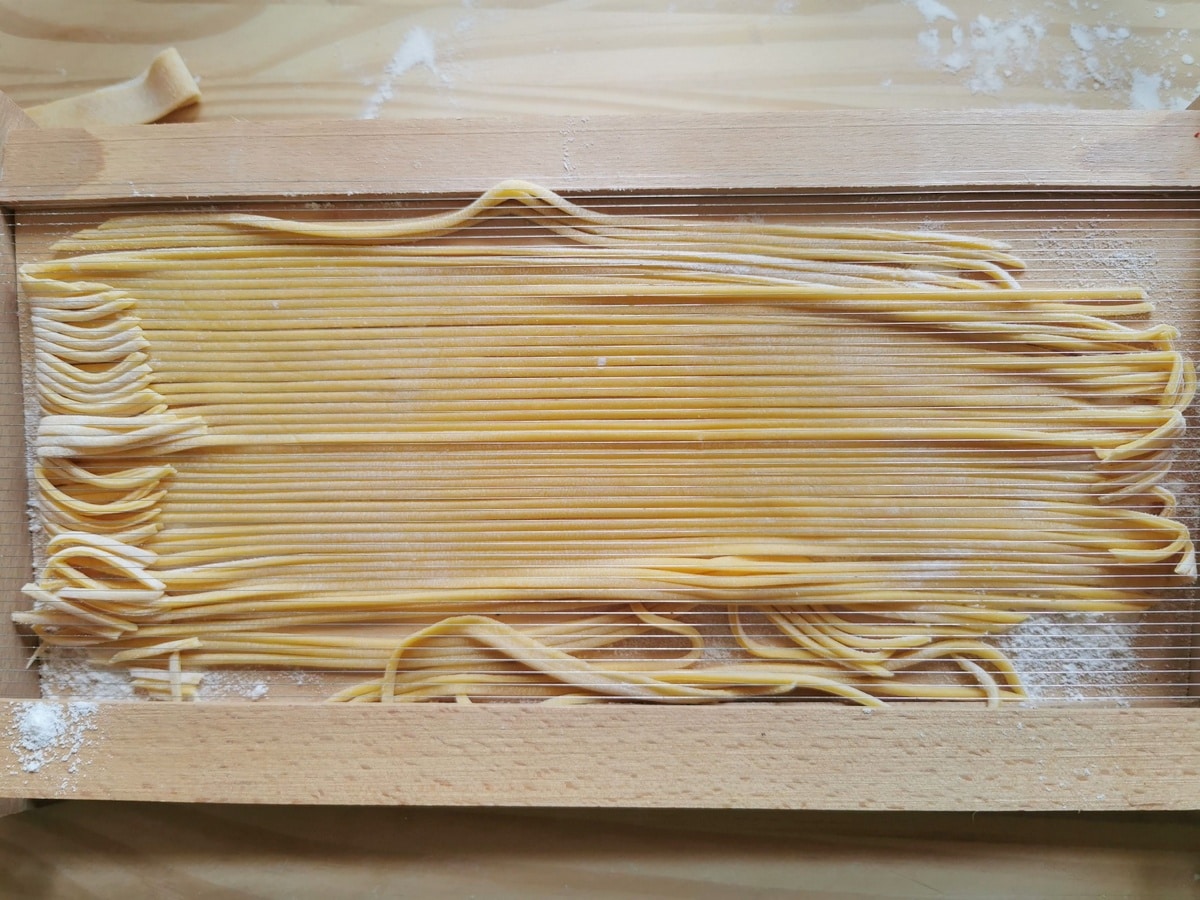

Dust with a generous amount of semolina flour and then lay the pasta sheet on the chitarra. If your sheet is longer than the chitarra you can cut it so there is space between the top and bottom ends of the dough and the point where the chitarra strings end.
Alternatively, fold the overlapping dough onto the strings after you have started to push some of the pasta through with your rolling pin.


Roll a rolling pin over the sheet of dough, applying an even amount of pressure from top to bottom. Repeat this motion until the sheet is cut and the spaghetti falls through the strings.
Flip the chitarra sideways and use one hand to catch the spaghetti as it slides through the open side. Drag the freshly cut spaghetti through more semolina flour before setting it aside on a sheet of baking paper or tea towel-lined tray.
Finish and Serve.
Put a pot of water onto boil for the pasta. Add salt once it starts to boil and bring to a boil again. Cook the spaghetti alla chitarra until al dente.
In the meantime, add the meatballs to the tomato sauce and simmer until heated through. Then remove some of the meatballs and a little sauce to pour over the alla chitarra once plated.


When the pasta is cooked, drain it and add it to the remaining sauce and meatballs. Mix everything together carefully over a low heat for a minute or two. Then plate and add some of the extra meatballs and sauce on top of the ready servings.
What to do with leftovers.
Any uncooked fresh spaghetti alla chitarra can be frozen and then cooked without defrosting.
You can keep any leftover pasta and Teramana sauce already mixed together sealed in the fridge for up to 3 days. Reheat in the microwave, or in a frying pan with a little butter or bake it in a hot oven with some grated cheese sprinkled on top.
If you have leftover cooked sauce and/or meatballs (without pasta) these can be frozen for up to 2 months.
Pin for later.
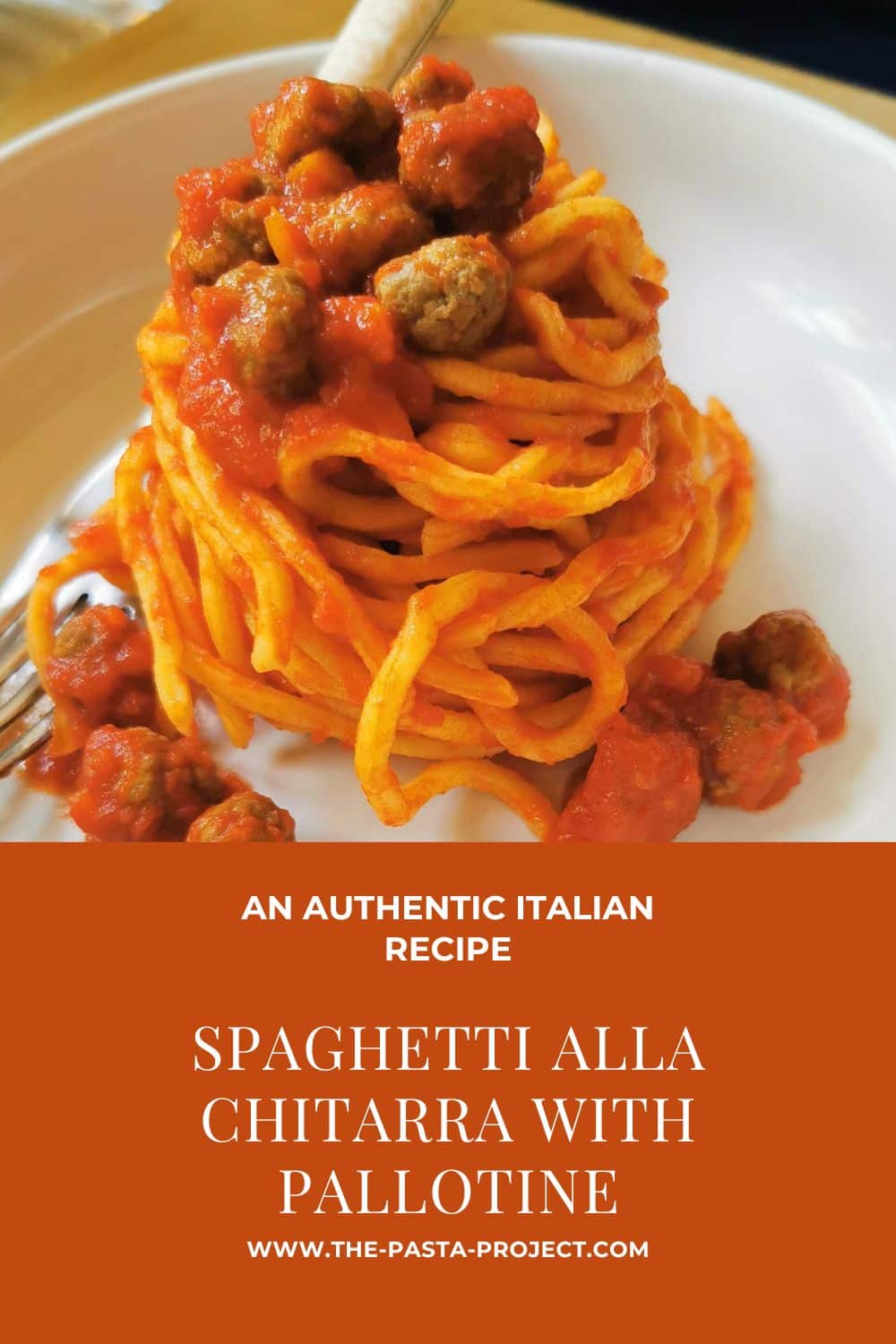

Let me know what you think.
Homemade spaghetti alla chitarra is such a delicious pasta. But, if you can’t make your own, you can use a dried version of the pasta. Either way, I’m sure you will love the alla teramana sauce with the tiny meatballs. The latter are such fun to make and very tasty!
If you try this spaghetti alla chitarra recipe at home, I’d love to hear how it turns out. Write a comment here on the blog or join and post a comment and photo on my Pastaliciousness Facebook group.
Your feedback is important to me!
Buon appetito!
Other homemade pasta recipes from Abruzzo to try.
- Homemade anellini pasta rings
- Homemade corn and wheat flour pasta triangles
- Fregnacce Abruzzesi, baked fazzoletti (handkerchief) pasta.
- Cannelloni all’abruzzese
If you are interested in buying a chitarra or other traditional pasta making tools check out my shop page (affliate links). Plus while you’re there why not order a copy of one of my pasta recipe cookbooks? They make great prezzies for pasta lovers!
More Spaghetti/Maccheroni alla Chitarra
Reader Interactions

